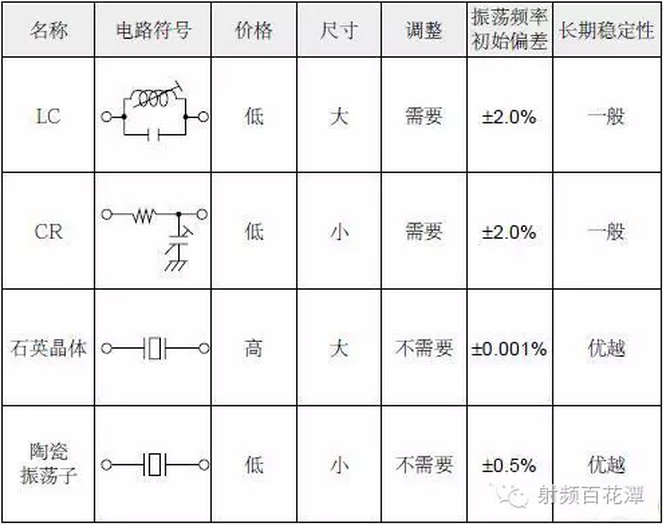Analysis of the Differences, Advantages and Disadvantages between Resonators and Oscillators?

The resonator and oscillator are often confused. After some time comparison, I'll sort it out. We are used to call crystal oscillator, which is actually very vague. Here the active is called oscillator and the passive is called resonator.
Resonator [RESONATOR]
The electronic component that generates resonant frequency is a typical passive device, which needs peripheral circuit to drive its work and generate clock output.
Oscillator [OSCILLATOR]
It is an energy conversion device, which converts DC power into AC power with a certain frequency. Its circuit is called oscillating circuit. The oscillator is an active device, and the oscillator has one more control circuit than the resonator.
From left to right are crystal resonator, ceramic resonator, crystal oscillator and silicon oscillator.

Crystal Resonator [QUARTZ CRYSTAL UNITS] [CRYSTAL]
Quartz crystal, commonly known as crystal, is an important piezoelectric material with SIO 2 composition. Its main characteristic is that its atoms or molecules are arranged regularly, which reflects the symmetry of the shape on the macro level. Under the action of electric field, stress and deformation occur in the crystal, which results in mechanical vibration and specific frequency. Quartz crystal resonators are manufactured by using the inverse piezoelectric effect of the crystal. Quartz possesses the natural high quality factor Q, which enables the crystal to maintain high accuracy and frequency stability in the whole operating temperature and voltage range.

Advantages: The signal level is variable, that is to say, it is determined by the starting circuit. The same crystal can be applied to a variety of voltages, and can be used for a variety of wafers with different clock signal voltage requirements, and the price is usually low. The precision of crystal resonator is 1 PPM (one millionth) to 100 PPM.
Disadvantage: Crystal resonator is a non-polar element with two pins. It needs clock circuit to generate oscillation signal, so it can not oscillate itself. Compared with crystal oscillator, the defect of crystal resonator is that the signal quality is poor. Usually, it needs to match the peripheral circuit (capacitance, inductance, resistance for signal matching) accurately. When changing the crystal with different frequencies, the peripheral configuration circuit needs to be adjusted accordingly.
Crystal resonators have some equivalent parameters. Different operating environments may have different requirements. Environmental temperature, load capacitance, frequency accuracy and other requirements should also be taken into account when choosing the resonator. This requires some control of the parameters of the peripheral oscillator circuit to output stable frequency.
Ceramic Resonator [CERAMIC RESONATOR]
Ceramic resonator is a piezoelectric ceramic device used to oscillate at a specific frequency. The materials used to make this kind of equipment will excite resonance characteristics during the production process. Because this resonance characteristic is within the production error range and its quality factor is far lower than that of quartz, the frequency stability of ceramic resonator is not as good as that of crystal resonator. Usually ceramic resonators are used in low cost and low performance requirements.
Advantages: Compared with crystals, ceramic resonators cost only half as much as crystals and are smaller in size.
Disadvantages: Compared with crystals, the lack of frequency and temperature stability. Its accuracy is poor, ranging from 1% to 0.1%.
Summary: The typical initial accuracy of ceramic resonators ranges from 0.5% to 0.1%, which may be changed by drift caused by aging or temperature change. The tolerance of inexpensive ceramic resonators is only [1.1%], while the vehicle accuracy of the higher end is [0.25%] and [0.3%]. Future applications will be applied to automotive CAN (Controller Local Area Network) bus applications, with operating temperatures ranging from - 40 C to + 125 C. Low-cost ceramic resonators with frequencies ranging from 200 KHZ to about 1 GHZ are suitable for embedded systems with less strict timing requirements. Ceramic devices start faster and are generally smaller than quartz devices. They are also better able to withstand shock and vibration.
All resonant elements are compared:
Crystal Oscillator [CRYSTAL OSCILLATOR]
crystal
Advantages: Crystal oscillator signal quality is good, relatively stable, and relatively simple connection (mainly to do a good job of power filter, usually using a capacitor and inductor PI filter network, output using a small resistance to filter the signal), do not need complex configuration circuit. Crystal oscillators have relatively good performance for time-sensitive applications.

Disadvantage: Compared with crystal resonator, the defect of crystal oscillator is that its signal level is fixed. It needs to choose the appropriate output level, which is less flexible and expensive. In addition, the quartz oscillator takes a long starting time.
Volume: Crystal oscillators are usually larger than passive crystals. With the improvement of technology, some crystal oscillators are surface mounted, and their volume is comparable to that of crystal resonators.
Silicon oscillator
Silicon oscillator, a fully integrated oscillator, is the simplest clock source. These devices can generate square waves of prescribed frequencies, which can be directly fed into the clock input of the single chip computer. The silicon oscillator does not depend on the mechanical resonance characteristics to obtain the oscillation frequency, but on an internal RC time constant. This design makes silicon devices insensitive to external mechanical effects. Unlike traditional oscillators, silicon oscillators can withstand greater humidity and EMI effects without exposed high impedance nodes. The silicon oscillator does not require a rigorously matched timing element and circuit board routing.
Prev:Talking about the influen..
Next:Rf power tolerance and th..



